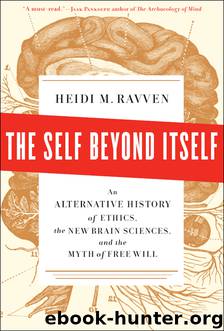The Self Beyond Itself by Heidi M. Ravven

Author:Heidi M. Ravven [Ravven, Heidi M.]
Language: eng
Format: epub
ISBN: 9781595588005
Publisher: New Press, The
Can anyone ever engage in open-minded, non–post hoc reasoning [i.e., moral reasoning that does not consist in rationalizations after the fact] in private? Yes . . . [but that is] hypothesized to occur somewhat rarely outside of highly specialized subcultures such as that of philosophy, which provides years of training in unnatural modes of human thought.22
Moral intuitions are set by a process of evolution plus social exchanges, they say, hence their term for it: a social intuitionist model (or SIM). It is a species-wide model offering moral insights that evolved for and in the species, so it offers what they regard as true or real morals for all human beings while also allowing for cultural nuances.
Haidt and Bjorklund see the unconscious and conscious systems as generally in competition, but the edge is almost always given to the unconscious quick one. “Modern social cognition research,” Haidt and Bjorklund remark, “is largely about the disconnect between automatic processes, which are fast and effortless, and controlled processes, which are slow, conscious, and heavily dependent on verbal thinking.”23 Their hypothesis about how SIM works is that in the great majority of morally “eliciting situation[s],” a person’s unconscious and primitive “like-ometer” settles on a moral judgment via the quick and automatic route. Then either more recently evolved conscious cognitive processes (reason) rationalize the already made moral judgment or social persuasion intrudes to modify the quick automatic judgment toward that of social partners. This social persuasion also generally operates, they maintain, via automatic, unconscious influences rather than via conscious reasoning and rational discourse.24 In rare cases, two other routes of moral judgment are possible: in the first, consciously reasoning together with others, such as in a philosophy class, results in a moral judgment; in the other, private conscious rational reflection results in such valuation. But these cases, they say, are unusual.
Thus moral judgment, in Haidt and Bjorklund’s estimation, turns out to be generally, and in almost all cases other than highly specialized ones, the result of the primitive automatic affective cognitive system. Higher cognition comes in largely as ex post facto rationalization, on one hand, and as social persuasion that merely nuances the primitive, on the other. As the authors suggest, this is a contemporary version of Hume’s notion of reason as slave to the passions, and hence of how (primitive) emotions drive morals.25 Moral judgment can be stopped in its tracks, however—for example, by other intuitions or by socially modified and mediated valuations. They offer an example of a prejudiced immediate feeling toward someone based on race or sex or something of that kind. A person can block that fast judgment in the light of other valuations; in their view, most of these other valuations would be obtained at least initially via social persuasion. Nevertheless, they maintain that “moral reasoning is . . . usually engaged in after a moral judgment is made, in which a person searches for arguments that will support an already-made judgment.”26 Haidt and Bjorklund conclude by identifying a set of
Download
This site does not store any files on its server. We only index and link to content provided by other sites. Please contact the content providers to delete copyright contents if any and email us, we'll remove relevant links or contents immediately.
The remains of the day by Kazuo Ishiguro(8892)
Tools of Titans by Timothy Ferriss(8304)
Giovanni's Room by James Baldwin(7251)
The Black Swan by Nassim Nicholas Taleb(7056)
Inner Engineering: A Yogi's Guide to Joy by Sadhguru(6752)
The Way of Zen by Alan W. Watts(6552)
Asking the Right Questions: A Guide to Critical Thinking by M. Neil Browne & Stuart M. Keeley(5708)
The Power of Now: A Guide to Spiritual Enlightenment by Eckhart Tolle(5679)
The Six Wives Of Henry VIII (WOMEN IN HISTORY) by Fraser Antonia(5455)
Astrophysics for People in a Hurry by Neil DeGrasse Tyson(5151)
Housekeeping by Marilynne Robinson(4392)
12 Rules for Life by Jordan B. Peterson(4275)
Double Down (Diary of a Wimpy Kid Book 11) by Jeff Kinney(4240)
The Ethical Slut by Janet W. Hardy(4212)
Skin in the Game by Nassim Nicholas Taleb(4202)
Ikigai by Héctor García & Francesc Miralles(4173)
The Art of Happiness by The Dalai Lama(4090)
Skin in the Game: Hidden Asymmetries in Daily Life by Nassim Nicholas Taleb(3961)
Walking by Henry David Thoreau(3922)
